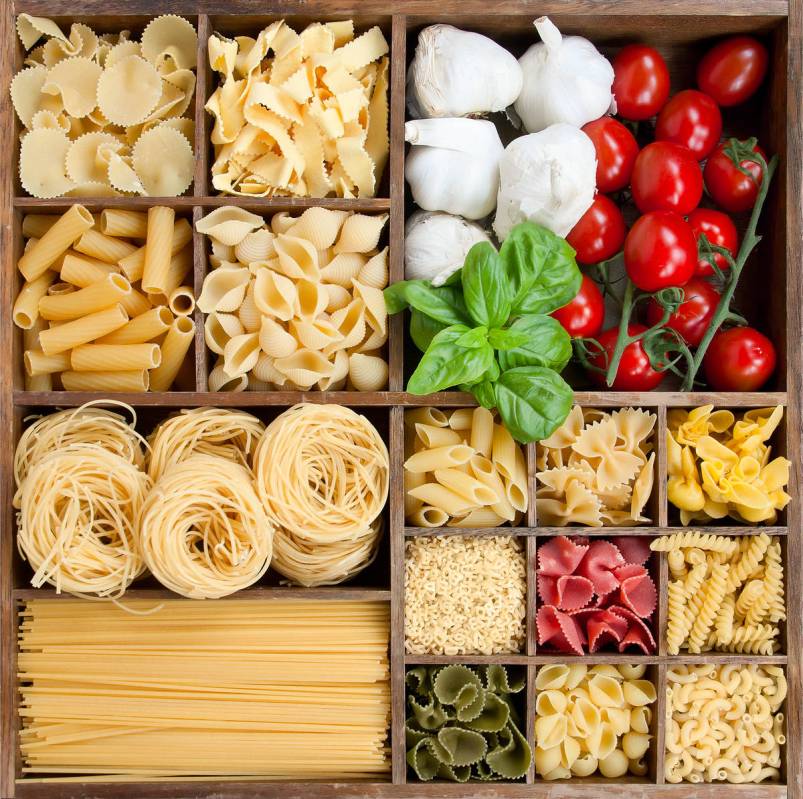Cooking during coronavirus times means be creative, flexible

Dustin Lewandowski, Las Vegas culinary director of the Wolfgang Puck Fine Dining Group, is realistic about what home cooks have to work with these days.
“At this point, I think people need to take what they can get,” Lewandowski said. “The essentials, if you can get hold of them, are fresh produce; make great use of it for the short term. Use what’s available on the shelves.”
Also, don’t overlook your own pantry, because you may have forgotten what’s there. Lewandowski said a survey of his found some varieties of pasta he had forgotten, different types or rice and beans and some canned clams.
“Certain ingredients that you might have, like ham or salami, incorporate into a bean stew,” he said. “Stretch it out with chicken stock or water.”
Van-Alan Nguyen, co-owner of 595 Craft and Kitchen at 4950 S. Rainbow Blvd., said he’s been perusing his home pantry and thinking creatively. One thing he finds extremely useful is rice.
“It’s super-versatile,” Nguyen said. “You can cook it; you can keep it.” And he reminded that the day-old stuff actually is better when making fried rice, which can be a go-to at such times.
“You can make it with pretty much anything,” he said.”If people have frozen peas and carrots, they can add soy sauce, some garlic. Take the old rice, heat that up, add everything and keep stirring until everything’s mixed together. If I have spinach, I’ll wilt the spinach and add that. It’s super-simple. I think anybody can do that.”
If you have some vegetables in the fridge that are a little past their prime, he suggests pickling them: Combine 1 cup vinegar, 2 cups water, 1/4 cup of sugar and 2 tablespoons salt, mix well to dissolve the sugar and salt, and submerge the vegetables in it.
“That should increase their shelf life for at least a month,” he said.
When you can get them, Lewandowski suggests stocking up on proteins that can be frozen, such as ground beef, chicken and turkey.
Jack Bishop, chief creative officer of America’s Test Kitchen, said to consider such meats as ground beef and poultry blank canvases.
“You can do almost anything with it,” he said. “It’s cheap. It’s Mexican one night, Italian the next night.” And a lot of times such things are at the heart of comfort foods such as pizzas and lasagnas.
“Make friends with beans,” Bishop said. “If you’re going to buy one kind of bean, buy chick peas. They work in anything from soups to pasta dishes, hummus.”
“Shelf-stable canned goods are very important,” Lewandowski said. “Beans, canned soups, canned vegetables to be used at a later point. Obviously pasta is a great thing; I know we loaded up at our house.”
“Garlic and onions,” Bishop said. “Most recipes use one or the other, and they keep for a long time. Olive oil; make sure you have an extra bottle on hand. It makes everything better. Make sure you’ve got butter in the freezer. Get a big hunk of Parmesan. Doesn’t it make everything taste better? And it lasts for months in the fridge.”
And salt.
“You’re going to be cooking more,” Bishop said. “It’s really basic, but you don’t want to run out of it.”
Most of all, they said, be flexible. Lewandowski said this is a good time to think about moving to smaller portions.
“I was training my kids this morning to put less milk on their cereal and not leave it behind,” he said. “We’re a society of convenience. We have everything at our fingertips, from convenience meals to eating out and leaving food behind. I think it’s something people are realizing they were taking for granted.”
Bishop and Lewandowski advised cooking in bulk, portioning out meals and freezing some for later, or maybe sharing with a friend of neighbor who needs assistance.
Be mindful, too, this this is not a time for strict adherence to use-by dates on packages; they’re more about food quality than food safety. Of course, be mindful of food safety, freezing or consuming while it’s still fresh.
“You’re going to make substitutions,” Bishop said. “That’s a given at this point. Even the simplest recipes, you may need to adapt to what you have on hand. That’s OK.”
“It’s a time of being resourceful and being creative and doing things out of your comfort zone,” Lewandowski said. “Turning your family on to new ideas and maximizing what’s available.”
If you don’t know where to start, he suggests Googling the ingredients you have on hand and “recipe.” America’s Test Kitchen also has posted a paywall-free resource of recipes and advice; visit americastestkitchen.com and click on the “Practical Home-Cooking Resources You Can Count On During COVID-19” banner at the top of the page. It also has videos. Another good source for information and videos is epicurious.com.
“Just relax and enjoy it,” Bishop said. “This is not a time to think about perfection. This is a time to think about cooking as a way to not watch the news and take a little break from all of it. It’s good for you.”
Contact Heidi Knapp Rinella at Hrinella@reviewjournal.com or 702-383-0474. Follow @HKRinella on Twitter.